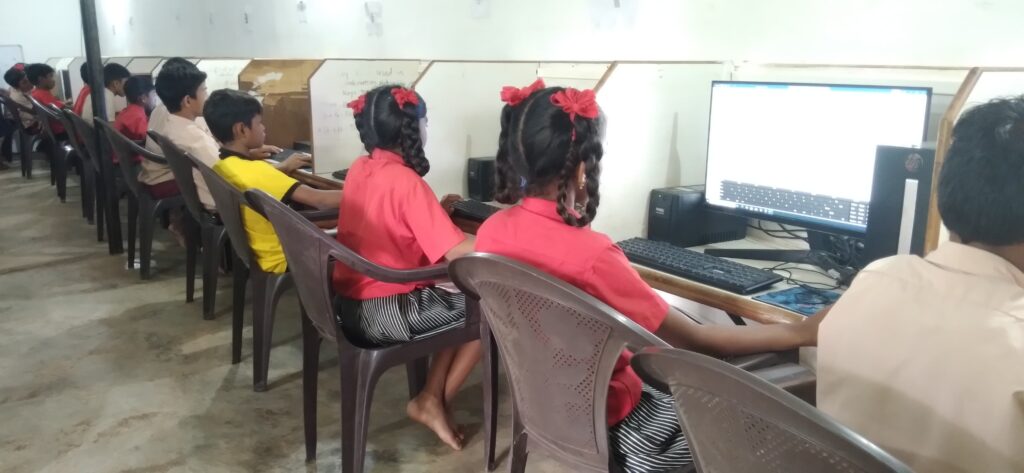Across India, affordable private schools face the same challenge: how to attract more parents in a crowded market. Most schools compete by cutting fees or promising “extra tuitions,” but parents today want more—they want their children to be future-ready.
This conversation between a school principal and a parent exploring admission shows how adopting APNA PCs can not only improve learning but also become the single biggest differentiator for affordable private schools looking to double their admissions.

Parent: Sir, I’ve been visiting many schools in this area. Honestly, they all seem the same—same classrooms, same textbooks, same promises. Why should I choose your school for my daughter?
Principal: That’s a fair question. Most schools focus on buildings and results, but we focus on giving your child the right tools for learning. That’s why we’ve introduced APNA PCs into our classrooms.
Parent: PCs? But children are so small. Don’t they just need books and teachers?
Principal: Books and teachers are essential, yes. But think about the world your daughter is growing into. Everything—jobs, careers, communication—is digital. If schools don’t prepare children to be tech-ready, they’ll always be one step behind. By introducing APNA PCs, we give students the power to learn beyond the textbook, explore concepts interactively, and develop confidence with technology from the start.
Parent: Hmm. But won’t that make school fees even higher? We’re already struggling with expenses.
Principal: That’s the beauty of the APNA PC—it’s affordable. At just ₹9,999, it costs less than two months of tuition fees. And because it’s designed for education, not entertainment, it provides long-term value. For the school, this investment becomes a marketing advantage. Parents see that we’re not just teaching for exams—we’re preparing children for the future.
Parent: I see your point. But will students really benefit, or is this just a showpiece for admissions?
Principal: Let me give you an example. In science, instead of just drawing diagrams of the water cycle, our students run simulations on their PCs—seeing clouds form, rain fall, and evaporation happen in real time. They don’t just memorize; they understand. That level of engagement keeps them motivated. And parents notice the difference when children come home excited about what they learned.
Parent: That sounds impressive. But how does this help you as a school to get more admissions?
Principal: Because parents like you are looking for something different. When every school claims “good teachers” and “strong academics,” parents choose the one that offers real value beyond marks. By showing that we provide APNA PCs in every classroom, we signal that we’re forward-thinking, future-ready, and serious about quality education. Word spreads fast, and more parents want admission here.
Parent: So you’re saying technology isn’t just for learning—it’s also for positioning the school as innovative?
Principal: Exactly. Think of it like this: in the past, parents chose schools with the best playgrounds or libraries. Today, they choose schools with the best technology. The APNA PC is our way of saying, “We care about your child’s future, not just their report card.”
Parent: But will children misuse it? I’ve heard stories of kids spending hours gaming.
Principal: Good concern. The APNA PC is customized for learning. It comes with preloaded educational apps, parental dashboards, and restricted access, so students use it productively. Teachers guide them in school, and parents can track usage at home. It’s a safe learning tool, not a gaming console.
Parent: I must admit, this is different from other schools I visited. But how do you handle affordability for all students?
Principal: We offer a shared model in classrooms, where PCs are used in groups. For parents who want their child to have a personal PC, we connect them with Teach to Earn’s subsidy program so they can buy one at home. This way, every child benefits—whether in school or at home.
Parent: That makes sense. Honestly, I’m convinced. This isn’t just another school—it feels like a school preparing my daughter for the future.
Principal: And that’s why we’ve seen admissions grow. Parents want their children to learn, not just pass. With APNA PCs, we deliver that promise.
Affordable private schools don’t need flashy buildings or inflated promises to stand out. They need to show parents that their children will be prepared for the future. APNA PCs provide that edge—keeping students engaged, boosting learning outcomes, and doubling admissions.
👉 If you’re a school leader, don’t compete only on fees. Compete on future-readiness.
Partner with Teach to Earn and equip your classrooms with APNA PCs today.
👉 Learn more at https://www.teachtoearn.in/affordable-private-schools-revolutionize-learning-with-praho/
